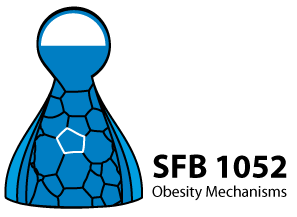B4 - Zielgerichtete Medikamentenfreisetzung in Adipozyten durch ein Peptid-basiertes Transportsystem – Untersuchungen an einem neuen Mausmodell für Adipositas
Basierend auf eigenen Erkenntnissen wollen wir Tamoxifen (Tam) mithilfe eines Peptid-vermittelten Abgabesystems selektiv in Adipozyten unseres neuen spontanen Leptinrezeptor-mutierten Mausmodells in vivo transportieren. Wir werden ein System für das fettzellspezifische Tamoxifen-Targeting unter Verwendung des Neuropeptids Y1Receptor etablieren und die molekularen Mechanismen von Tamoxifen im Fettgewebe während der Entwicklung von Fettleibigkeit aufklären, mit dem Ziel eine alternative therapeutische Strategie auf klinischer Ebene zu identifizieren.

Abbildung 1: Adipozyten, isoliert aus der SVF-Fraktion von subkutanem Fett von BL6-, db/db- und Obis-Mäusen.
Weiner J, Roth L, Kranz M, Brust P, Boelen A, Klöting N, Heiker JT, Blüher M, Tönjes A, Pfluger PT, Stumvoll M, Mittag J, Krause K. Leptin counteracts hypothermia in hypothyroidism through its pyrexic effects and by stabilizing serum thyroid hormone levels. Mol Metab. 2021 Oct 2:101348.
Hoffmann A, Ebert T, Hankir MK, Flehmig G, Klöting N, Jessnitzer B, Lössner U, Stumvoll M, Blüher M, Fasshauer M, Tönjes A, Miehle K, Kralisch S. Leptin Improves Parameters of Brown Adipose Tissue Thermogenesis in Lipodystrophic Mice. Nutrients. 2021 Jul 22;13(8):2499.
Berger C, Heyne HO, Heiland T, Dommel S, Höfling C, Guiu-Jurado E, Roßner S, Dannemann M, Kelso J, Kovacs P, Blüher M, Klöting N. A novel compound heterozygous leptin receptor mutation causes more severe obesity than in Lepr db/db mice. J Lipid Res. 2021 Aug 11:100105.
Berger C, Klöting N. Leptin Receptor Compound Heterozygosity in Humans and Animal Models. Int J Mol Sci. 2021 Apr 25;22(9):4475.
Kunath A, Weiner J, Krause K, Rehders M, Pejkovska A, Gericke M, Biniossek ML, Dommel S, Kern M, Ribas-Latre A, Schilling O, Brix K, Stumvoll M, Klöting N, Heiker JT, Blüher M. Role of Kallikrein 7 in Body Weight and Fat Mass Regulation. Biomedicines 2021, 9, 131.
Rolle-Kampczyk U, Gebauer S, Haange SB, Schubert K, Kern M, Moulla Y, Dietrich A, Schön MR, Klöting N, von Bergen M, Blüher M. Accumulation of distinct persistent organic pollutants is associated with adipose tissue inflammation. Sci Total Environ. 2020 Dec 15;748:142458.
Klöting N, Ristow M, Blüher M. Effects of exercise on ACE2. Obesity (Silver Spring). 2020 Sep 17.
Kunath A, Heiker JT, Kern M, Kosacka J, Flehmig G, Stumvoll M, Kovacs P, Blüher M, Klöting N. Nicotinamide Nucleotide Transhydrogenase (Nnt) Is Related to Obesity in Mice. Horm Metab Res . 2020 Jul 6.
Nono Nankam PA, Blüher M, Kehr S, Klöting N, Krohn K, Adams K, Stadler PF, Mendham AE, Goedecke JH. Distinct abdominal and gluteal
adipose tissue transcriptome signatures are altered by exercise training in African women with obesity. Sci Rep. 2020 Jun 24;10(1):10240.
Dommel S, Berger C, Kunath A, Kern M, Gericke M, Kovacs P, Guiu-Jurado E, Klöting N, Blüher M. The Fabp4-Cre-model is insufficient to study Hoxc9 function in adipose tissue. Biomedicines . 2020 Jun 29;8(7):E184.
Jacobi T, Massier L, Klöting N, Horn K, Schuch A, Ahnert P, Engel C, Löffler M, Burkhardt R, Thiery J, Tönjes A, Stumvoll M, Blüher M, Doxiadis I, Scholz M, Kovacs P. HLA Class II Allele Analyses Implicate Common Genetic Components in Type 1 and Non–Insulin-Treated Type 2 Diabetes. J Clin Endocrinol Metab. 2020 Mar 1;105(3).
Wittrisch S, Klöting N, Mörl K, Chakaroun R, Blüher M, Beck-Sickinger AG. NPY1R-targeted peptide-mediated delivery of a dual PPARα/γ agonist to adipocytes enhances adipogenesis and prevents diabetes Progression. Mol Metab. 2020 Jan;31:163-180.
Abshagen K, Berger C, Dietrich A, Schütz T, Wittekind C, Stumvoll M, Blüher M, Klöting N. A Human REPIN1 Gene Variant: Genetic Risk Factor for the Development of Nonalcoholic Fatty Liver Disease. Clin Transl Gastroenterol. 2020 Jan;11(1):e00114.
Klöting N, Kern M, Moruzzi M, Stumvoll M, Blüher M. Tamoxifen treatment causes early hepatic insulin resistance. Acta Diabetol. 2020 Jan 6.
Zelicha H, Kaplan A, Yaskolka Meir A, Tsaban G, Rinott E, Shelef I, Tirosh A, Brikner D, Pupkin E, Qi L, Thiery J, Stumvoll M, Klöting N, von Bergen M, Ceglarek U, Blüher M, Stampfer MJ, Shai I. The Effect of Wolffia globosa Mankai, a Green Aquatic Plant, on Postprandial Glycemic Response: A Randomized Crossover Controlled Trial. Diabetes Care. 2019 Jul;42(7):1162-1169
Abshagen K, Mense L, Fischer F, Liebig M, Schaeper U, Navarro G, Glass Ä, Frank M, Klöting N, Vollmar B. Repin1 deficiency in liver tissue alleviates NAFLD progression in mice. J Adv Res. 2018 Nov 22;16:99-111.
Kosacka J, Woidt K, Toyka KV, Paeschke S, Klöting N, Bechmann I, Blüher M, Thiery J, Ossmann S, Baum P, Nowicki M. The role of dietary non-heme iron load and peripheral nerve inflammation in the development of peripheral neuropathy (PN) in obese non-diabetic leptin-deficient ob/ob mice. Neurol Res. 2019 Jan 13:1-13.
Abshagen K, Degenhardt B, Liebig M, Wendt A, Genz B, Schaeper U, Stumvoll M, Hofmann U, Frank M, Vollmar B, Klöting N. Liver-specific Repin1 deficiency impairs transient hepatic steatosis in liver regeneration. Sci Rep. 2018 Nov 15;8(1):16858.
Giusepponi ME, Kern M, Chakaroun R, Wohland T, Kovacs P, Dietrich A, Schön MR, Krohn K, Pucci M, Polidori C, Micioni Di Bonaventura MV, Stumvoll M, Blüher M, Cifani C, Klöting N. Gene expression profiling in adipose tissue of Sprague Dawley rats identifies olfactory receptor 984 as a potential obesity treatment target. Biochem Biophys Res Commun. 2018 Nov 2;505(3):801-806.
Wagner IV, Sahlin L, Savchuk I, Klöting N, Svechnikov K, Söder O. Adipose Tissue is a Potential Source of Hyperandrogenism in Obese Female Rats. Obesity (Silver Spring). 2018 Jul;26(7):1161-1167.
Hollenbach M, Klöting N, Sommerer I, Lorenz J, Heindl M, Kern M, Mössner J, Blüher M, Hoffmeister A. p8 deficiency leads to elevated pancreatic beta cell mass but does not contribute to insulin resistance in mice fed with high-fat diet. PLoS One. 2018 Jul 24
Krüger J, Berger C, Weidle K, Schleinitz D, Tönjes A, Stumvoll M, Blüher M, Kovacs P, Klöting N. Metabolic effects of genetic variation in the human REPIN1 gene. Circ Genom Precis Med. 2018 May;11(5):e001992.
Zieger K, Weiner J, Kunath A, Gericke M, Krause K, Kern M, Stumvoll M, Klöting N, Blüher M, Heiker JT. Ablation of kallikrein 7 (KLK7) in adipose tissue ameliorates metabolic consequences of high-fat diet induced obesity by counteracting adipose tissue inflammation in vivo. Cell Mol Life Sci. 2017; Epub ahead of print.
Hesselbarth N, Kunath A, Kern M, Gericke M, Mejhert N, Ryden M, Stumvoll M, Blüher M, Klöting N. Repin1 deficiency in adipose tissue improves whole-body insulin sensitivity, and lipid metabolism. Int J Obes (Lond). 2017; Epub ahead of print.
Weiner J, Rohde K, Krause K, Zieger K, Klöting N, Kralisch S, Kovacs P, Stumvoll M, Blüher M, Böttcher Y, Heiker JT. Brown adipose tissue (BAT) specific vaspin expression is increased after obesogenic diets and cold exposure and linked to acute changes in DNA-methylation. Mol Met. 2017; Epub ahead of print.
Kralisch S, Hoffmann A, Klöting N, Bachmann A, Kratzsch J, Stolzenburg JU, Dietel A, Beige J, Anders M, Bast I, Blüher M, Zhang MZ, Harris RC, Stumvoll M, Fasshauer M, Ebert T. FSTL3 is increased in renal dysfunction. Nephrol Dial Transplant. 2017; Epub ahead of print.
Haim Y, Blüher M, Konrad D, Goldstein N, Klöting N, Harman-Boehm I, Kirshtein B, Ginsberg D, Tarnovscki T, Gepner Y, Shai I, Rudich A. ASK1 (MAP3K5) is transcriptionally upregulated by E2F1 in adipose tisue in obesity, molecularly defining a human dys-metabolic obese phenotype. Mol Metab. 2017;6:725-36.
Braune J, Weyer U, Matz-Soja M, Hobusch C, Kern M, Kunath A, Klöting N, Kralisch S, Blüher M, Gebhardt R, Zavros Y, Bechmann I, Gericke M. Hedgehog sinaling in myeloid cells impacts on body weight, adipose tissue inflammation and glucose metabolism. Diabetologia. 2017;60:889-99.
Guiu-Jurado E, Unthan M, Böhler N, Kern M, Landgraf K, Dietrich A, Schleinitz D, Ruschke K, Klöting N, Faßhauer M, Tönjes A, Stumvoll M, Körner A, Kovacs P, Blüher M. Bone morphogenetic protein 2 (BMP2) may contribute to partition of energy storage into visceral and subcutaneous fat depots. Obesity (Silver Spring). 2016; Epub ahead of print.
Weingarten A, Turchetti L, Krohn K, Klöting I, Kern M, Kovacs P, Stumvoll M, Blüher M, Klöting N. Novel genes on rat chromosome 10 are linked to body fat mass, preadipocyte number and adipocyte size. Int J Obes (Lond). 2016; Epub ahead of print.
Kunath A, Hesselbarth N, Gericke M, Kern M, Dommel S, Kovacs P, Stumvoll M, Blüher M, Klöting N. Repin1 deficiency improves insulin sensitivity and glucose metabolism in db/db mice by reducing adipose tissue mass and inflammation. Biochem Biophys Res Commun. 2016;478:398-402.
Hankir MK, Kranz M, Gnad T, Weiner J, Wagner S, Deuther-Conrad W, Bronisch F, Steinhoff K, Luthardt J, Klöting N, Hesse S, Seibyl JP, Sabri O, Heiker JT, Blüher M, Pfeifer A, Brust P, Fenske WK. A novel thermoregulatory role for PDE10A in mouse and human adipocytes. EMBO Mol Med. 2016;8:796-812.
Pfeiffer S, Krüger J, Maierhofer A, Böttcher Y, Klöting N, El Hajj N, Schleinitz D, Schön MR, Dietrich A, Fasshauer M, Lohmann T, Dreßler M, Stumvoll M, Haaf T, Blüher M, Kovacs P. Hypoxia-inducible factor 3A gene expression and methylation in adipose tissue is related to adipose tissue dysfunction. Sci Rep. 2016;6:27969.
Stelzner K, Herbert D, Popkova Y, Lorz A, Schiller J, Gericke M, Klöting N, Blüher M, Franz S, Simon JC, Saalbach A. Free fatty acids sensitize dendritic cells to amplify TH1/TH17-immune responses. Eur J Immunol. 2016;46:2043-53.
Hoffmann A, Manjowk GM, Wagner V, Klöting N, Ebert T, Jessnitzer B, Lössner U, Stukenborg JB, Blüher M, Stumvoll M, Söder O, Svechnikov K, Fasshauer M, Kralisch S. Leptin within the subphysiological to physiological range dose-dependently improves male reproductive function in an obesity mouse model. Endocrinology. 2016;157:2461-8.
Baum P, Kosacka J, Estrela-Lopis I, Woidt K, Serke H, Paeschke S, Stockinger M, Klöting N, Blüher M, Dorn M, Classen J, Thiery J, Bechmann I, Toyka KV, Nowicki M. The role of nerve inflammation and exogenous iron load in experimental peripheral diabetic neuropathy (PDN). Metabolism. 2016;65:391-405.
Brune JE, Kern M, Kunath A, Flehmig G, Schön MR, Lohmann T, Dressler M, Dietrich A, Fasshauer M, Kovacs P, Stumvoll M, Blüher M, Klöting N. Fat depot-specific expression of HOXC9 and HOXC10 may contribute to adverse fat distribution and related metabolic traits. Obesity (Silver Spring). 2016;24:51-9.
Klöting N, Hesselbarth N, Gericke M, Kunath A, Biemann R, Chakaroun R, Kosacka J, Kovacs P, Kern M, Stumvoll M, Fischer B, Rolle-Kampczyk U, Feltens R, Otto W, Wissenbach DK, von Bergen M, Blüher M. Di-(2 Ehtylhexyl)-Phtalate (DEHP) causes impaired adipocyte function and alters serum metabolites. PLoS One. 2015;10:e0143190.
Krause K, Weiner J, Hönes S, Klöting N, Rijntjes E, Heiker JT, Geb
Doktorandin
Anna Kohler
|
Adresse (Büro):
|
Brüderstraße 34, 04103 Leipzig Raum: 352 |
|
Telefon:
E-mail:
|
0341 9736793
|
|
Thema des Promotionsprojektes:
|
Anna hat ihren Bachelorabschluss in Biochemie an der Universität Leipzig abgeschlossen. Ihre Bachelorarbeit hat sie an der Medizinischen Fakultät zu Thema nicht-kodierende RNAs und deren Relevanz in der Entwicklung der Alzheimer-Krankheit verfasst. Während ihres Masterstudiums war sie vor allem in Peptid-Therapeutika interessiert. Ihrem Interesse folgend schloss sie sich der Projektgruppe von Prof. Anette Beck-Sickinger an um dort ihre Dissertation zu beginnen. Hier forscht sie neuen Therapieansätzen zur Behandlung von Adipositas. |

Doktorandin
Sontje Krupka
|
Adresse (Büro):
|
Zentrales Forschungsgebäude, Liebigstr. 21/Haus C Room No.: 1016 |
|
Telefon:
E-mail:
|
0341 9713400
|
|
Thema des Promotionsprojekts:
|
In my doctoral thesis, I use an obese mouse model to investigate whether an adipose tissue-specific peptide-drug conjugate has an impact on obesity and its comorbidities with reduced systemic side effects.
In addition, I am involved in investigating the effects of exposure to selected xenobiotics on adipose distribution and adipose tissue function in project B1 mouse models. |

Doktorandin
Anna Kruscha
| Adresse (Büro): | Brüderstraße 34, 04103 Leipzig 352 |
|
Tel.: (Labor/ Büro):
E-Mail:
|
0341 9736793
|
|
Thema des Promotionsprojekts:
|
Anna hat ihren Bachelorabschluss in Biochemie an der Universität Leipzig abgeschlossen. Ihre Bachelorarbeit hat sie an der Medizinischen Fakultät zu Thema nicht-kodierende RNAs und deren Relevanz in der Entwicklung der Alzheimer-Krankheit verfasst.
Während ihres Masterstudiums war sie vor allem in Peptid-Therapeutika interessiert. Ihrem Interesse folgend schloss sie sich der Projektgruppe von Prof. Anette Beck-Sickinger an um dort ihre Dissertation zu beginnen. Hier forscht sie über selective adipocyte-adressing peptide-drug conjugates zur Behandlung von Adipositas. |



